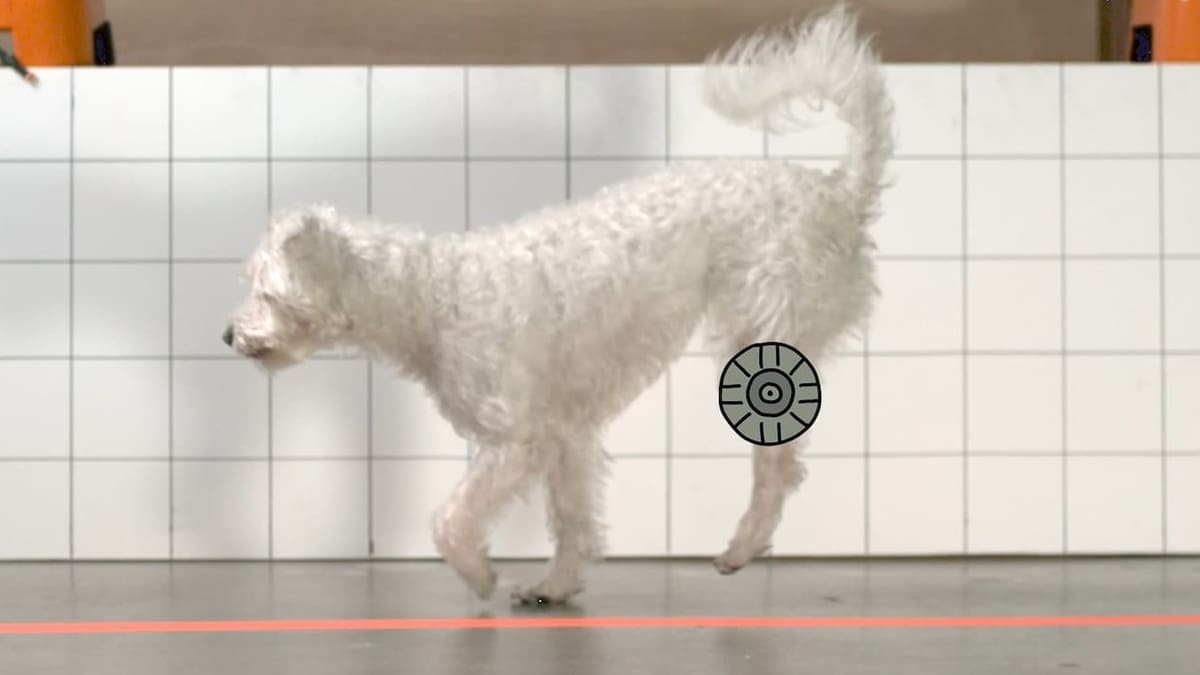Dogs’ disabilities can be a cause of abandonment, euthanasia, and difficulty in finding an owner and happy home. This is because it’s typically understood that the life of a dog, under such circumstances, is tougher than the life of a regular dog – the pet will require more care and attention to do ordinary tasks. However, those who accept the compromise of taking care of and loving disabled dogs realize that they can adapt very quickly to physical challenges.
While stifle braces can be an excellent solution, sometimes more is needed. Prosthetics can play a major role in helping the dog overcome difficulties in adapting to a new life without a leg or in reliving some pain caused as a result of overloading the remaining members.
In this article, we’ll mainly cover the most common type of dogs’ prostheses, which are prosthetic limbs.
There are two forms of dog limb prostheses: endoprostheses and exoprostheses. Before we jump into our list, let’s look a bit more into this.
Types of Prostheses
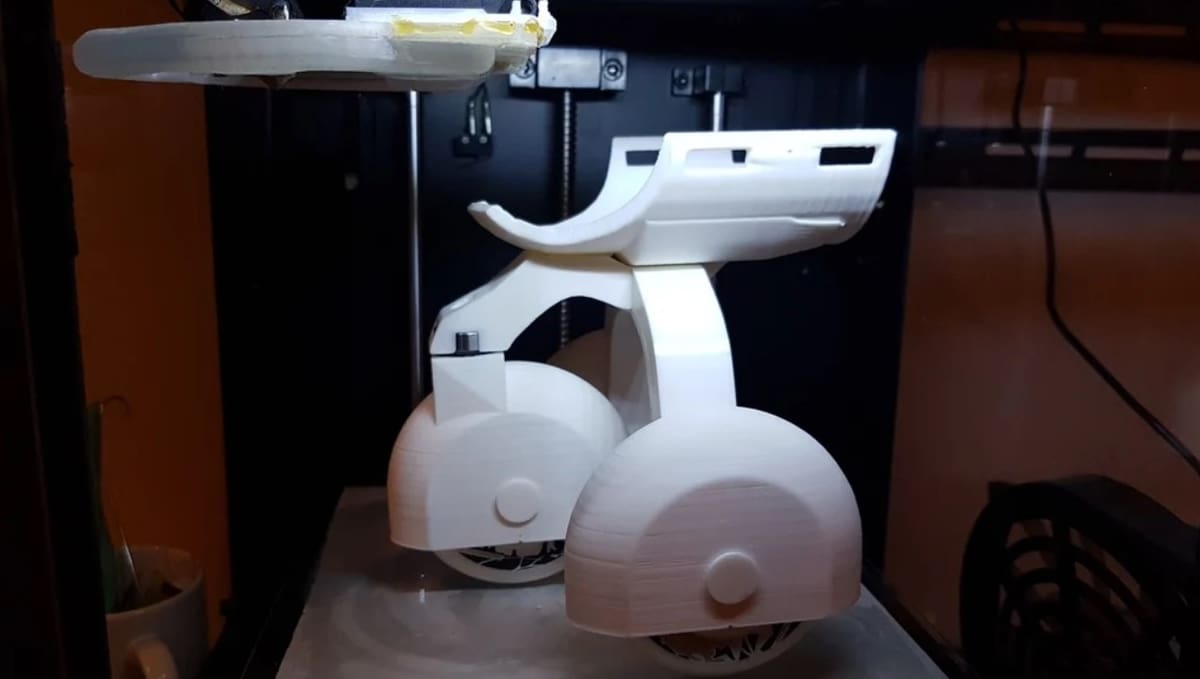
Endoprostheses are intended to replace a joint or bone and, as such, are internally placed and joined to remaining bone, being left inside the dog and having an external part. The exoprosthesis is only placed externally, where the missing member used to be. This article will cover only the last type, which we will refer to as “prosthetic” for simplicity.
Besides appearing in different configurations, the regular components of a limb prosthetic are:
- The suspension system, which consists of belts that allow the prosthetic to be attached to the dog.
- The socket and the liner, which are mounted together and offer the interface between the prosthetic and the remaining limb. The socket is a rigid and anatomic structure, while the liner is made of a padding material to make it comfortable.
- The pylon, which is the main structure of the prosthetic, warranting the proper length and weight support.
- The terminal foot, which is the flexible interface between the pylon and the ground.
Before diving into the list of the best DIY dog prosthetics, it’s important to mention that a prosthetic’s craft must be assisted by a veterinarian throughout the process, from the beginning to its completeness. The main goal of a prosthesis is to increase the dog’s quality of life by helping it imitate its gait as if it had all its members. To do that, a biomechanic analysis of the gait is necessary, as well as a confirmation that a prosthesis is indeed required.
Now, let’s check the criteria that we considered while selecting the best DIY dog prosthetics.
Proposed Criteria
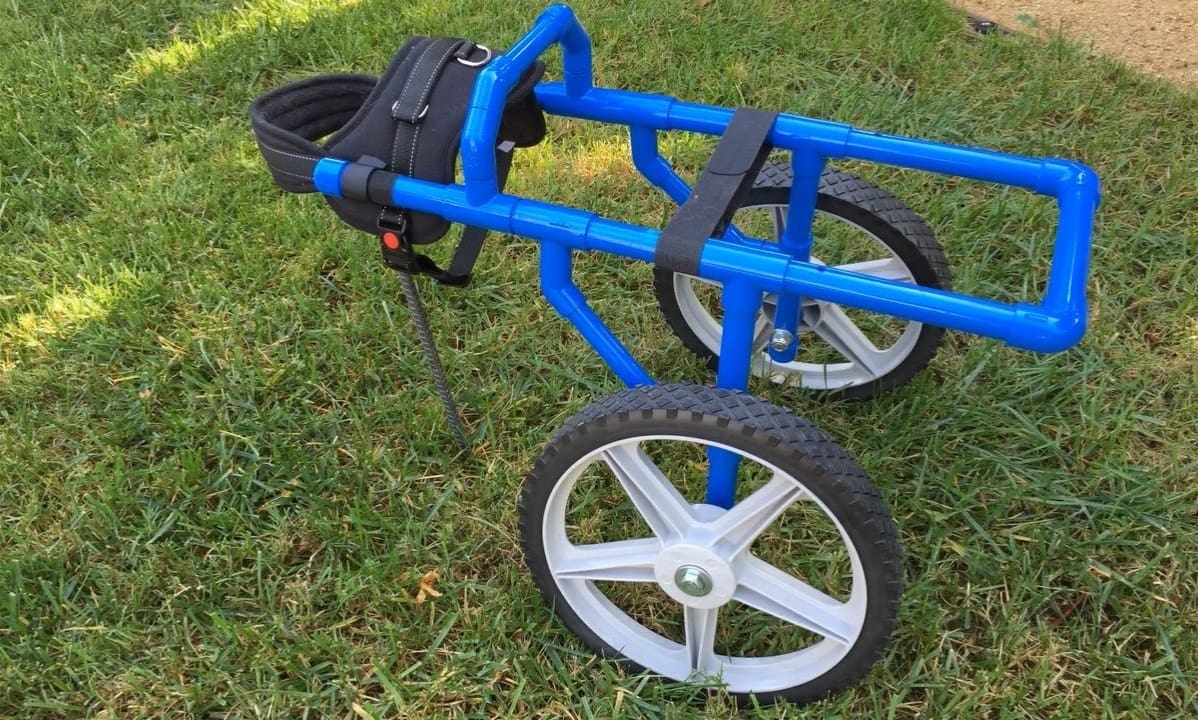
To list the best DIY prosthetics for dogs, we took into consideration some core aspects that need to be met, whether you want to replicate it or if you’re looking for a project as a starting point.
- Concluded works: It’s important to understand the project as a whole, so only finished projects are included in the article. Works in progress were skipped, as final results and ease of use couldn’t be verified.
- Publishing date: Considering that the article intends to bring updated information about DIY prosthetics, recent projects were prioritized.
- Tested designs: The main goal of designing a prosthetic is to increase disabled pets’ well-being, so projects tested in real dogs were prioritized, as it’s evidence of the quality of the design.
- Embracing projects: We prioritized designs that have the potential to be tailored to the variety of dog breeds, sizes, and needs, rather than having a list of projects that are all meant for the same breed of dog or that only address one issue.
By considering these criteria, it was possible to establish a list of the best DIY prosthetics for dogs. Let’s dive into the picks!
Rigid Partial Limb Prosthetic
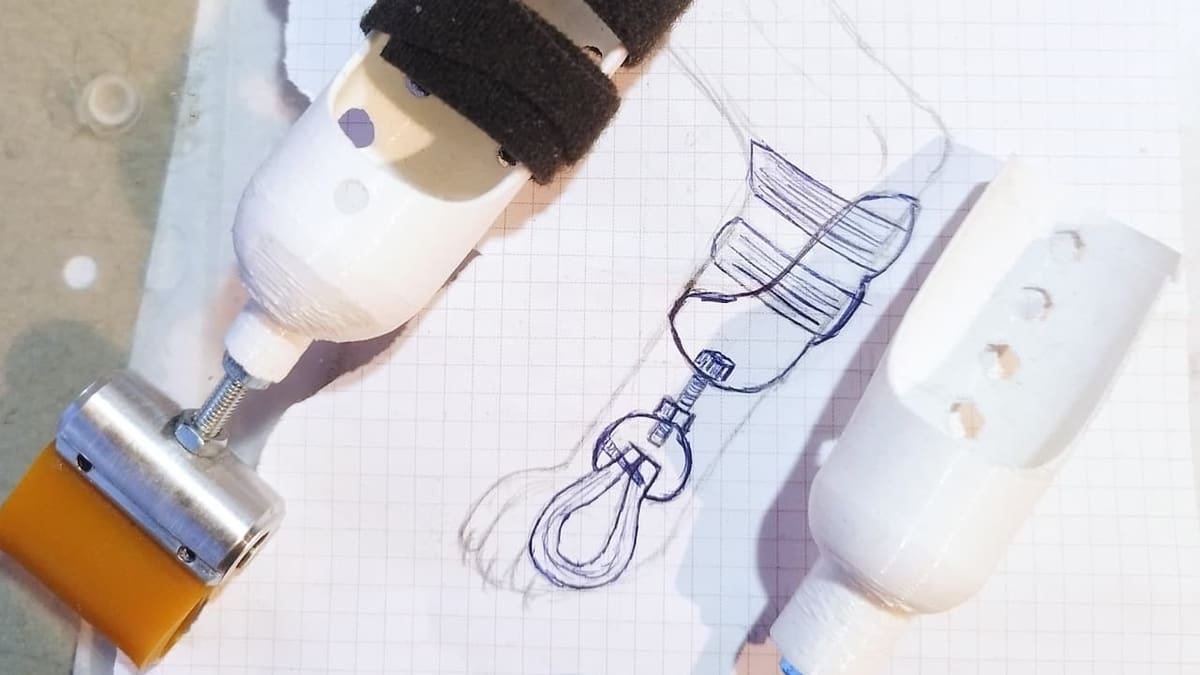
Partial limb prosthetics are used when the dog has lost the part of the leg from the joint to the paw. The front limb joint is called carpal, while the rear limb joint is called tarsal. So, the partial leg prosthetic can also be known as a carpal or tarsal prosthetic.
jonVillaRobre’s Prosthesis for Cat or Dog is a great example of a carpal or tarsal prosthetic. It’s made of a 3D printed socket that is tightened to the residual limb with Velcro straps. The pylon was designed to offer height control and shock absorbance. It consists of a screw with nuts, which control the size of the prosthetic according to the pet’s height, and a 3D printed clip that fixes a rubber, which is responsible for the prosthetic’s impact absorbance.
Although it’s not mentioned to have been tested on an actual pet, its design is quite similar to cutting-edge prostheses sold in specialized shops. In addition to the STL, the SolidWorks file was shared, so it can be modified to the proper dimensions of your pet. While not mentioned in the design, adding liner to the socket would provide a soft interface between the remaining leg and the socket’s rigid wall.
- How replicable is it? This design is highly replicable. All the files are free to download, and the CAD file is available if you need to make any changes to fit your pup.
- Who designed it? jonVillaRobre
- What is it made of? 3D printed parts, screws and nuts, rubber, Velcro straps, and a pad for the lower inner part.
Rigid Full Limb Prosthetic
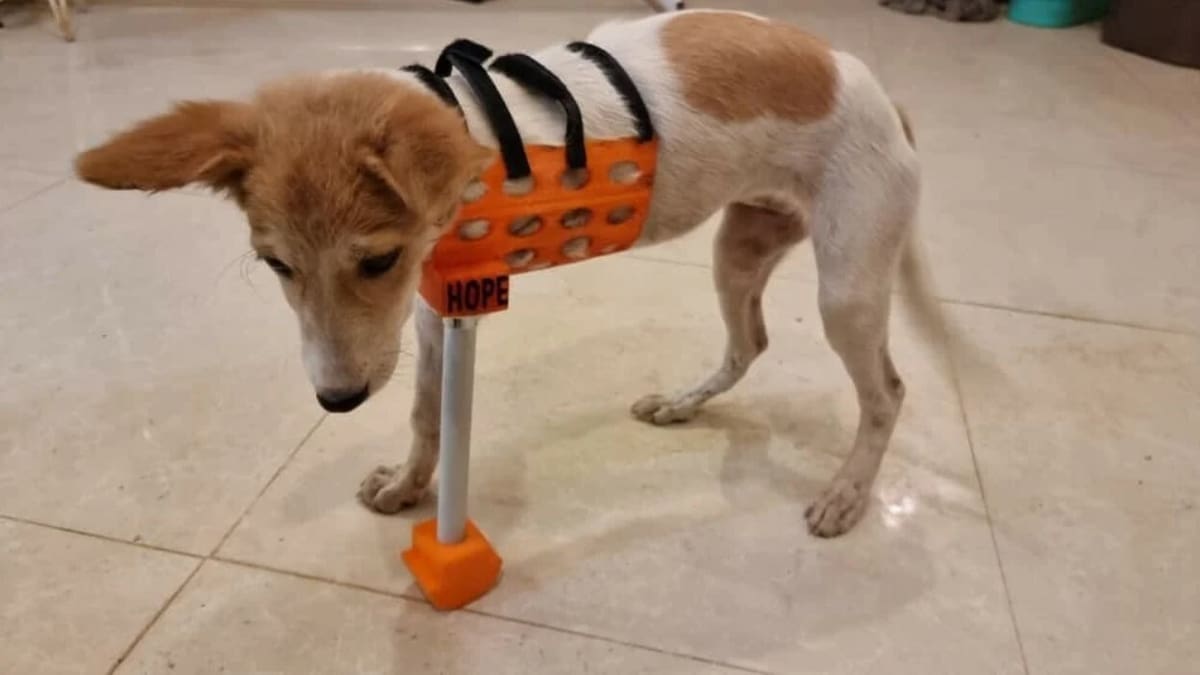
In specific situations, a complete leg amputation is needed. For those cases, full limb prosthetics may be needed if the dog shows signs of pain or discomfort in three legs. This might be more necessary for front limb amputation because a great part of the dog’s weight is loaded in this region.
To help a tripod-rescued dog named Hope, Thingiverse maker Merg1234 designed a full limb prosthetic with a rigid pylon. It has a chest support printed in PETG that attaches to the dog’s body with Velcro straps. The rigid pylon is actually a rod that is fixed to the support and to the terminal foot, which in turn is 3D printed in TPU.
- How replicable is it? This full limb prosthetic is pretty replicable. While all the files are free to download, only STL files are available, so they will have to be converted if they need to be edited (e.g. to STEP).
- Who designed it? Merg1234
- What is it made of? It’s very DIY-friendly, as it includes 3D printed parts, a rod, and Velcro straps.
Rigid Full Limb Prosthetic with Anatomic Brace
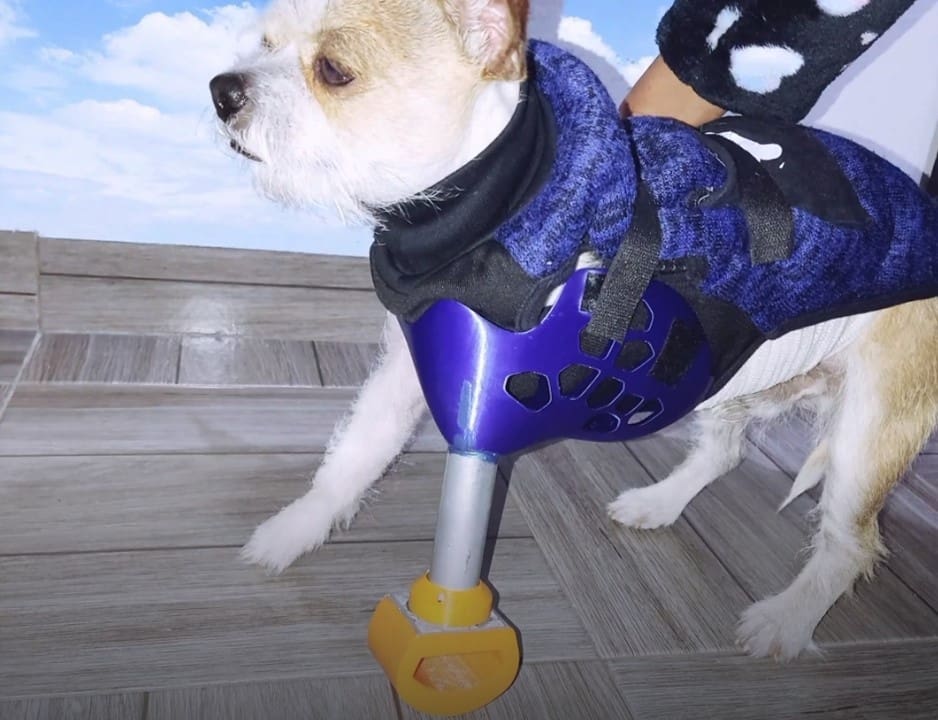
Another type of full limb prosthetic was designed by Fdesign and shared in Cults. Different from the previous one, this prosthetic is completely 3D printed, including the pylon. In addition, the chest support is more anatomic. The designer even recommends printing the chest support and the terminal foot with flexible material, such as TPU, and having the pylon be printed with a more rigid material.
The designer has uploaded other types of dog prostheses, considering different disabilities and concepts. These include left and right articulated prostheses for front limbs, fully 3D printed left and right flexible prosthetic for rear limbs, and finally a height-adjustable front limb prosthetic. However, it should be noted that only the model pictured above is shown to have been printed.
- How replicable is it? While only this particular model has been shown to be 3D printed, the others shouldn’t present significant challenges. It should be noted that all the models mentioned are paid (~$10 each).
- Who designed it? Fdesign
- What is it made of? The design is meant to be fully 3D printed, with flexible and rigid parts.
Robotic Limb Prosthetic
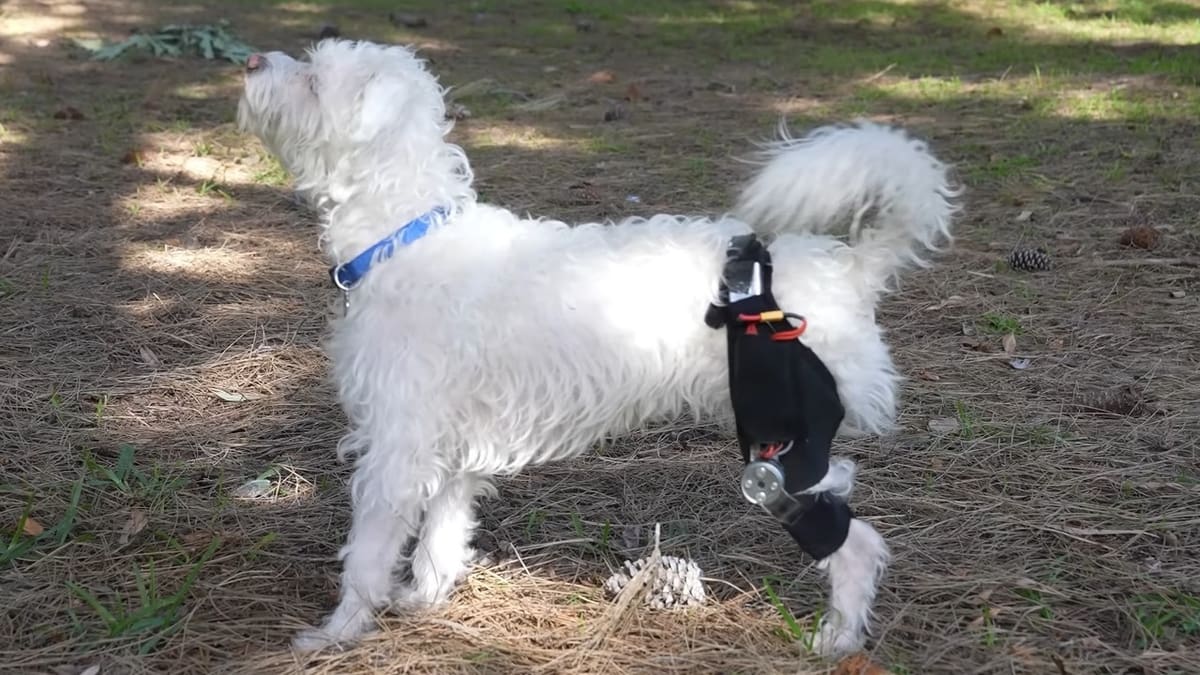
Tripod dogs frequently suffer from a lot of strain in their single limb. It can even lead to arthritis and elbow joint issues, potentially needing surgery in the remaining legs.
To help her three-pawed friend Scraps, who was showing signs of discomfort in her remaining leg, Simone Giertz designed a harness that alleviates the weight of the leg. It uses a motor controller in knee height, so it applies a torque in the contrary direction of the joint movement. That way, it reduces the impact of the leg on the ground.
- How replicable is it? It’s not easy to replicate, as it doesn’t have a step-by-step guide or a bill of materials, but the explanations in the video can be a good starting point for makers with some know-how to see how the idea can be implemented.
- Who designed it? Simone Giertz
- What is it made of? It’s a harness with a case made of fabric to house the electronics and the battery, plus the motor controller.
Cart Replacing Two Front Limbs
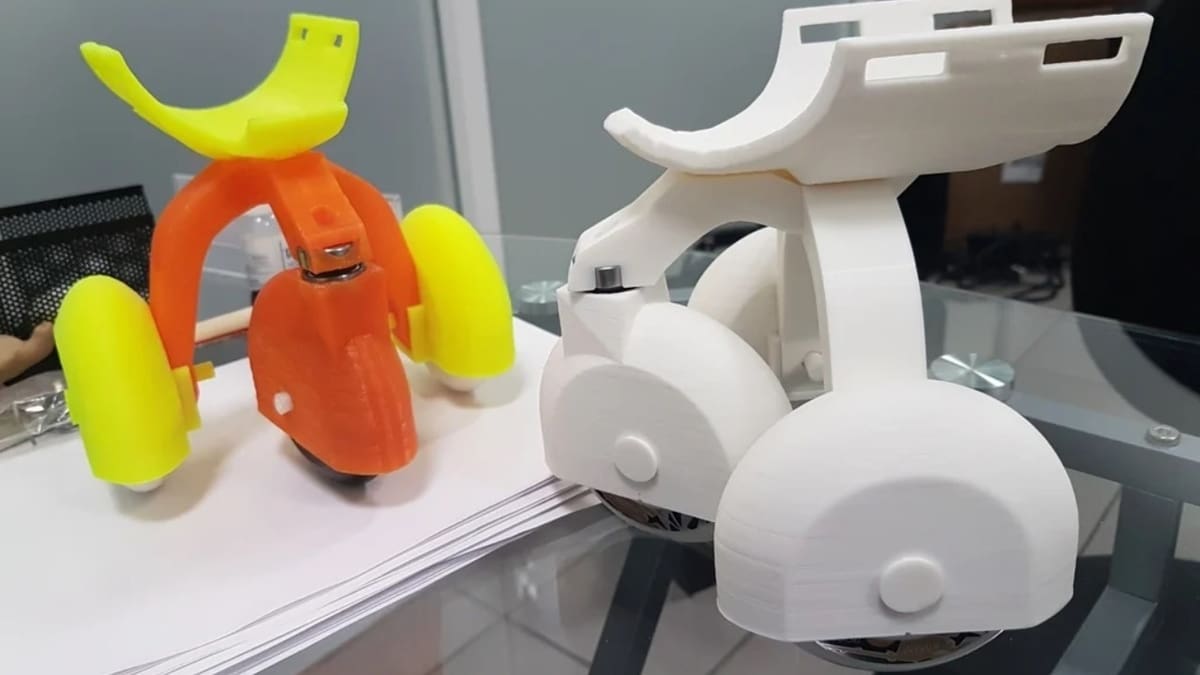
In some cases, dogs are born without two front limbs, or they might experience a traumatic situation, such as an accident, that results in losing both front legs. In spite of that, dogs can adapt and live a life as four-leg dogs, albeit needing some assistance.
To aid dogs with such conditions, dmsantiagog has designed a cart that can replace the two front limbs. It has a chest support with holes to keep the dog on the cart with some straps. Different from regular prosthetics, it doesn’t have a proper pylon or terminal foot, instead having three wheels.
As the model was designed for a Chihuahua, the wheels and bearings used were from skates. So, to be adapted to bigger breeds, some parts of the model must be redesigned.
- How replicable is it? This cart is pretty replicable – a make has been shared, and the files have been downloaded around 2,000 times. All the files are free to download, but only STL files are available, so they will have to be converted to be eventually edited.
- Who designed it? dmsantiagog
- What is it made of? A maker-friendly model with 3D printed rigid parts, skate bearings, and skate wheels.
Cart for Supporting Two Rear Limbs
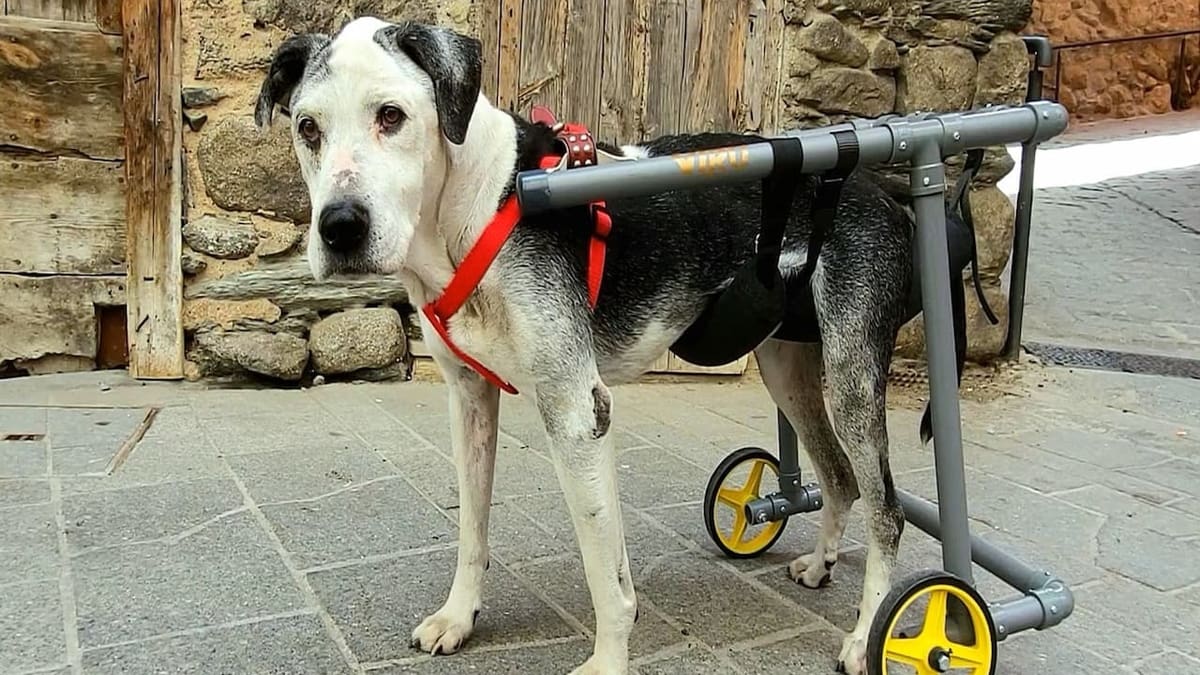
Tired of seeing his 15-year-old friend Biro suffering from osteoarthritis in his two rear limbs, maker ArtErnesto created a cart that serves as a stroller, allowing Biro to maintain his posture. In his video, it’s possible to see the step-by-step of the project, which uses an assembly of PVC pipes as the main structure. Different from a wheelchair (which we’ll look into further below), this cart is similar to a stroller, supporting the rear limbs’ weight and holding them at the proper position so that they can still be used to walk.
As osteoarthritis is a degenerative disease, it’s probable that, over time, a dog with Biro’s condition loses its rear limbs motor skills. For such a case, Ernesto also designed a pedal with socks that can house the paws, maintaining the rear legs’ muscles exercised as he walks.
PVC pipe is a common material for structuring prosthetic carts. Using this kind of material, hoc31rescue has made a similar design for Figgy, a dog with hip dysplasia. However, the video doesn’t go through step-by-step construction. Instead, the designer makes the building instructions available only through email. That said, it’s possible to notice from the video that the cart improved Figgy’s gait and mobility.
- How replicable is it? There isn’t a bill of materials, but the video is quite detailed, so one can follow the step-by-step and replicate the project, considering one’s dog’s measurements and needs.
- Who designed it? ArtErnesto
- What is it made of? While the model can be customized, ArtErnesto’s is made of PVC pipes, wheels, flexible foam to sustain the rear limbs, and some belts.
Cane for Blinding Dogs
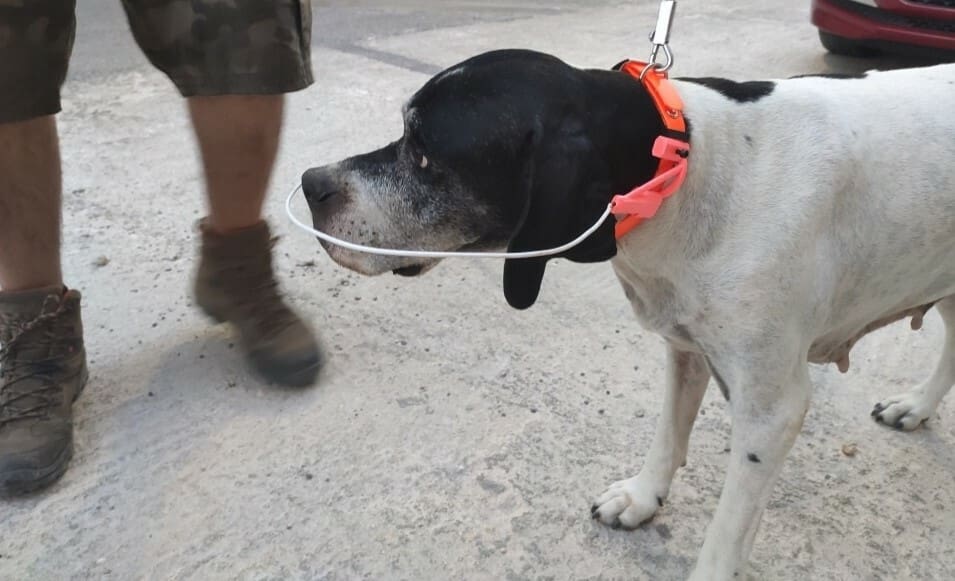
Dogs’ disabilities aren’t limited to limb issues. A different type of project is presented by JoaquinGC, who designed an assistive walking device to aid blind dogs so that they gain awareness of things ahead of them. It works somewhat similarly to a cane for blinding people, who can detect an object by its contact with the cane.
The device is made of two 3D printed supports that can be attached to the dog’s collar. The two supports are placed one on each side of the dog’s head. Next, you need to mold a rigid clothesline wire in a semicircle and seat it in the supports.
- How replicable is it? This aid is as replicable as they get. Only the STL file is available, so it will have to be converted to be eventually adjusted for bigger dogs, although the designer suggests that it may be best suited for smaller breeds.
- Who designed it? JoaquinGC
- What is it made of? An easy-to-make device, with 3D printed rigid parts, rigid clothesline wire, plus the dog’s collar.
Bonus: Dog Wheelchair
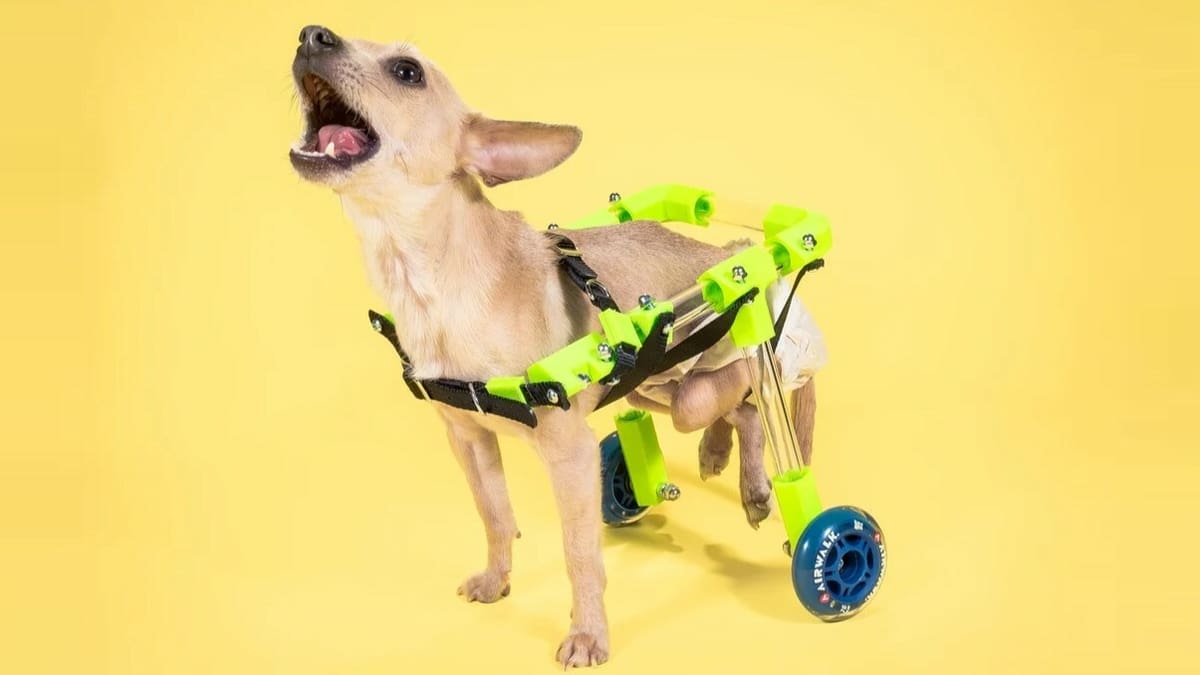
A challenging disability in dogs is when they don’t have mobility in their rear limbs. In such cases, a wheelchair is necessary to support the weight of the hips and rear limbs and to allow the dog to walk properly with its two front legs. Despite being similar to the carts mentioned earlier, this wheelchair features a padding support for keeping the rear legs suspended. It prevents the rear immobile legs from dragging on the ground as the dog walks.
The FiGO wheelchair created by Thingiverse designer Rickee has a quite simple concept. The 3D printed parts are only the joint pieces and the main structure is made of acrylic tubes, which can also be replaced by aluminum tubes. Besides that, the original project uses straps made of dog leashes to tighten the dog and support the hips, as well as wheels. Additionally, to adapt the wheelchair design for any dog, the designer has made available a spreadsheet to help with the calculations of the tubes’ sizes considering the dogs’ measurements.
This design is unique in terms of concept and about the kinds of materials used. For wheelchair DIY projects, it’s quite popular to use PVC pipes, like the ones showed by Mark Lapid’s DIY wheelchair for a French Bulldog and by J Von Stratton’s DIY dog wheelchair for a corgi. It’s interesting to note that, in both videos, the immobile rear legs dangled when the dogs first experimented with the wheelchairs. However, with time, the aids ended up stimulating the rear legs’ movements.
- How replicable is it? The project is very replicable, with a spreadsheet to help with calculations and the possibility to use the Customizer app in Thingiverse.
- Who designed it? Rickee
- What is it made of? This popular design is made up of 3D printed rigid parts, acrylic tubes, wheels (which might differ depending on the dog’s size), and straps.
Considerations for Your Prosthetic Project
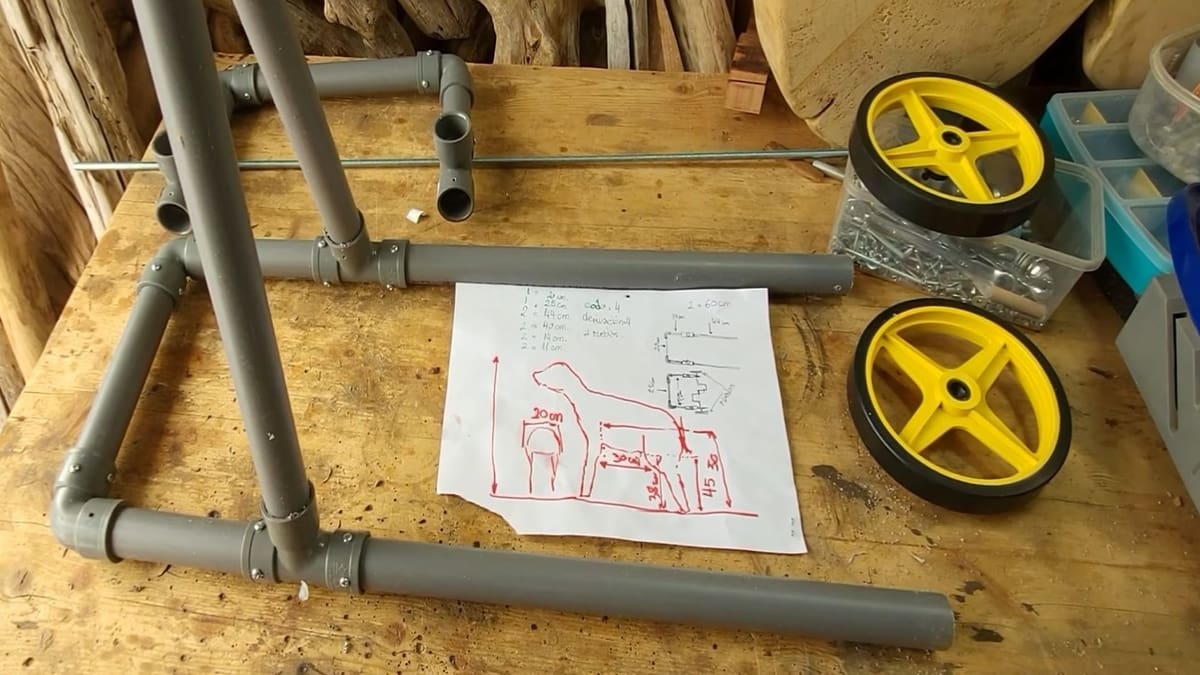
The prosthetics mentioned above show how they can improve dogs’ quality of life. If you’re looking to craft your dog a prosthesis from scratch, the importance of asking for a veterinarian’s assistance cannot be understated. In addition to this, the steps below offer an overview of what you’ll need throughout the process.
- Evaluation: The most important thing to do is evaluate if the dog really needs a prosthetic. As said previously, dogs are very resilient and can adapt quickly to a life without a limb. Observe your dog moving and search for clues of pain or discomfort in the remaining legs, or signs of wounds in the dog’s body that come from the act of improper walking movements. Ask for a vet’s assistance and experience in determining what will benefit your dog the most: a prosthesis or adapting to its new circumstances without one.
- Taking measurements: Having decided that a prosthetic will indeed improve the dog’s well-being, it’s time to take measurements. Every type of prosthetic requires a measurement of the dog’s anatomy dimensioning, so steps 2 and 3 will be done simultaneously. In this step, a good idea is to 3D scan your dog’s body with an Xbox Kinect or a similar device. It’s important that all measurements be exact, as even a few millimeters can lead to further discomfort or a device that won’t be suitable for your pet.
- Tinkering your prosthetic: Now it’s time to unleash your inner designer and come up with an idea to help your furry buddy. You can use one of the models listed above or design a completely innovative prosthetic. In this step, it’s probable that you’ll need to design with the aid of CAD software, taking into account the geometry and material of the main components of a prosthetic: The prosthesis must meet the anatomic and strength requirements.
- Fabrication: The fabrication process is highly dependent on the model you created and the materials chosen. Because of fabrication restrictions, you might need to redesign the model, which means returning to the 3rd step. For the actual fabrication, 3D printing is becoming very popular due to the possibility of producing highly complex geometries and disability-specific customized prosthetics in a variety of materials.
- Testing and evaluating: The last step is to test the prosthetic in your dog and evaluate if it fits well and if the dog’s gait is near what it would be if it wasn’t disabled. A prosthetic is only effective if it allows a disabled dog to mimic a four-legged dog’s gait, with comfort. If you realize that the prosthetic isn’t achieving this objective, it’s time to go back some steps and make all the necessary adjustments to make the prosthetic fit and function well.
During all these processes, in all these steps, you should be assisted and guided by a veterinarian, with biomechanics analysis. Only with a professional who possesses the relevant knowledge and experience will you be assured that you’ll bring quality of life to your furry friend, and not increase its issues.
Making a dog prosthetic can be a tough task. Iterations between steps are quite frequent until the best design is reached. From steps 2 to 4, each of them individually (or all of them) can be done with the assistance of a specialized professional or company. If you have the possibility, you can look into companies like 3D Pets, which make custom designs catering to specific needs.
Free help can be relatively easy to find online. For example, assistance is provided by the non-governmental organization e-NABLE, which originally created a community to connect people who need a hand prosthetic to people who can design and 3D print it for free. Now, e-NABLE is expanding the community to help animals with prosthetics as well.
Overall, it’s possible to help your dog with its needs. Don’t be afraid of inventing some new prosthetics if you really think it might offer your dog a better life. The limit of creativity and inventiveness is the limit of the love of an owner.
License: The text of "DIY Prosthetics for Dogs" by All3DP is licensed under a Creative Commons Attribution 4.0 International License.

